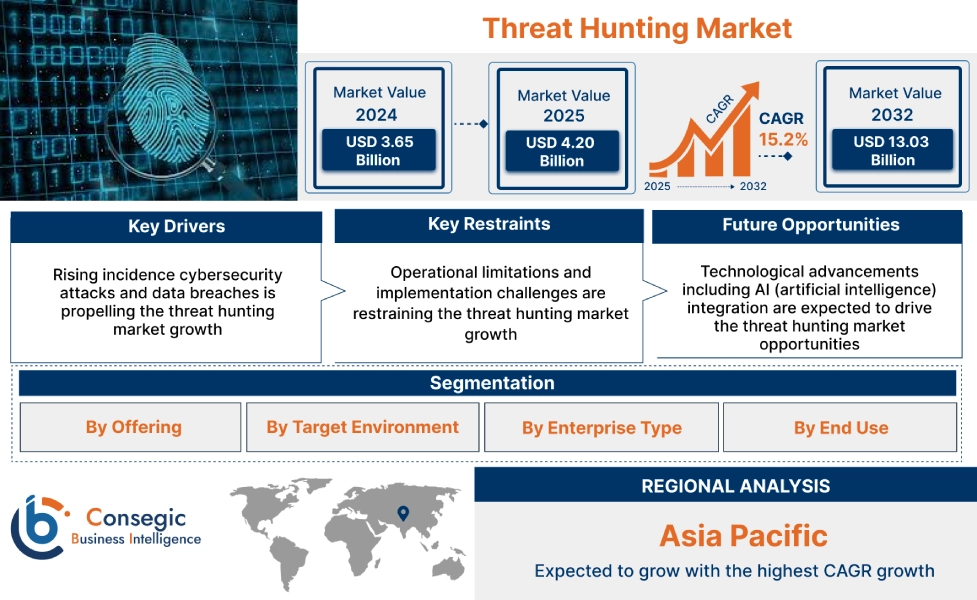Threat Hunting Market Size:
Threat Hunting Market size is estimated to reach over USD 13.03 Billion by 2032 from a value of USD 3.65 Billion in 2024 and is projected to grow by USD 4.20 Billion in 2025, growing at a CAGR of 15.2% from 2025 to 2032.
Threat Hunting Market Scope & Overview:
Threat hunting refers to a proactive cybersecurity approach that focuses on actively searching for and identifying potential threats that may have bypassed traditional security measures. It involves the use of advanced technologies for detecting malicious activities and vulnerabilities within an enterprise. Moreover, threat detection enables earlier detection and response to malicious activities, in turn minimizing potential damage and improving overall security resilience. Additionally, it also enhances incident response capabilities and strengthens security posture of an organization.
How is AI Transforming the Threat Hunting Market?
AI is transforming the global threat hunting market by empowering security teams to detect, analyze, and respond to threats faster and more accurately. With machine learning algorithms, AI examines through massive volumes of logs and telemetry to identify suspicious patterns or anomalies that could signal an attack. Further, it supports behavioral analytics, enabling predictive detection based on deviations from normal activity. AI also accelerates incident response by automating triage and enriching alerts with contextual data, helping analysts focus on high-risk threats. Additionally, AI models continuously learn from emerging attack techniques, enhancing detection over time. As cyber threats grow more sophisticated, AI-driven threat hunting tools are becoming essential for strengthening enterprise security and improving operational efficiency.
Threat Hunting Market Dynamics - (DRO) :
Key Drivers:
Rising incidence cybersecurity attacks and data breaches is propelling the threat hunting market growth
The current business landscape is witnessing a substantial increase in the volume of cybersecurity threats and data breaches from cyber criminals. Business enterprises are increasingly exposed to data loss and security breaches, where sensitive information is stolen or compromised. Moreover, data breaches can be very costly for business enterprises, in terms of both financial and brand reputation. As a result, organizations are investing in advanced security measures to actively identify and mitigate threats before they can cause significant damage, in turn leading to increased adoption of threat hunting solutions.
- For instance, according to the Identity Theft Resource Center (ITRC), the total number of data breaches in the United States reached 3,205 breaches in 2023, representing a substantial increase of 78% in comparison to 1,801 data breaches in 2022.
Therefore, the increasing number of data breaches and cybersecurity attacks is increasing the demand for threat-hunting solutions, in turn propelling the threat hunting market size.
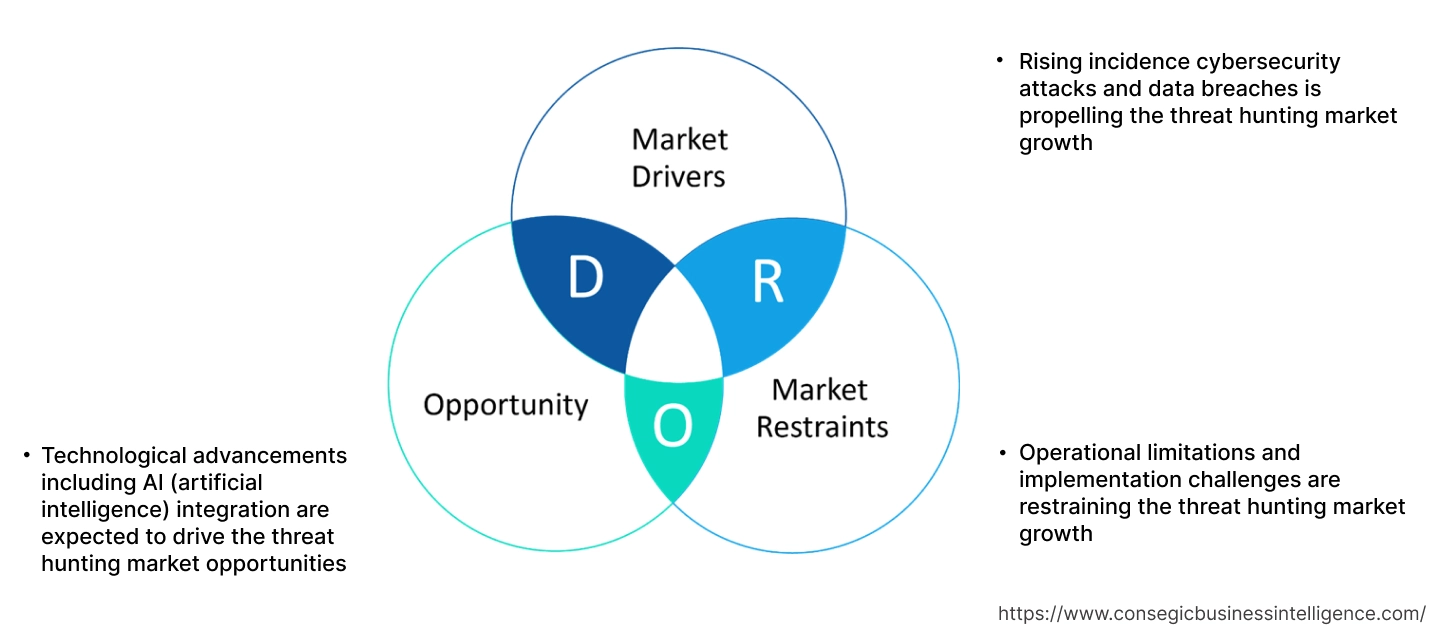
Key Restraints :
Operational limitations and implementation challenges are restraining the threat hunting market growth
Threat hunting is associated with certain operational limitations and challenges, which are among the key factors limiting the market. For instance, the primary limitations related to threat-hunting include false positives, tooling issues, resource constraints, complexities related to sensitive data retention and handling, and others.
Moreover, threat-hunting often results in a high number of false alarms, which can be quite challenging to manage and potentially lead to a decreased level of confidence in the security team's findings. Additionally, threat hunting requires significant investment in tools, skilled personnel, and time, which can be a barrier for organizations with limited financial resources. Thus, the aforementioned factors are hindering the threat hunting market expansion.
Future Opportunities :
Technological advancements including AI (artificial intelligence) integration are expected to drive the threat hunting market opportunities
AI-powered threat-hunting leverages artificial intelligence for automating and enhancing the process of detecting, analyzing, and responding to cyber threats more effectively. AI algorithms can analyze vast amounts of security data to identify unusual patterns and behaviors that may indicate a security breach. Additionally, AI-powered threat-hunting offers several benefits, including continuous monitoring, faster investigation, automated responses, improved accuracy, streamlined workflows, and others.
- For instance, in July 2025, Fortra today introduced its latest AI-driven features for improved threat-hunting capabilities within its Cloud email protection solution offering. The new AI-powered features are capable of improving the detection of sophisticated social engineering attacks and threats.
Hence, as per the analysis, technological advancements such as AI integration with threat-hunting solutions are projected to boost the threat hunting market opportunities during the forecast period.
Threat Hunting Market Segmental Analysis :
By Offering:
Based on offering, the market is segmented into solutions and services.
Trends in the offering:
- Rising adoption of threat-hunting solutions in business enterprises for identifying and neutralizing potential cyber threats and enhancing overall security is driving the market.
- Increasing adoption of threat-hunting services for cost-effective detection of any potential threats, their impact, and recommendations for remediation is boosting the market.
The solutions segment accounted for the largest revenue share in the overall market in 2024, and it is anticipated to register a significant CAGR during the forecast period.
- The solutions segment includes security information and event management (SIEM), endpoint detection and response (EDR), user and entity behaviour analytics (UEBA), managed detection and response (MDR), and other related solutions.
- These solutions leverage a combination of tools, techniques, and threat intelligence to detect malicious activities and strengthen overall security posture.
- SIEM provides a central platform for collecting and analyzing security logs, enabling threat hunters to identify patterns and anomalies across the environment.
- Moreover, EDR provides detailed visibility into endpoint activities, which enables threat hunters to identify malicious activity, investigate incidents, and take appropriate actions.
- Additionally, UEBA solutions use machine learning and behavioural analytics to detect anomalies in user and entity behaviour, which helps in identifying threats that may be overlooked by traditional security tools.
- For instance, IBM is a threat-hunting solution provider that offers cyberthreat hunting solutions in its offerings. This solution is capable of detecting, investigating, and remediating threats more quickly by finding hidden patterns and connections.
- Thus, according to the analysis, the rising advancements related to network threat-hunting services are driving the market growth.
By Target Environment:
Based on target environment, the market is segmented into network, cloud, endpoint, and others.
Trends in the target environment:
- Increasing deployment of threat-hunting solutions for facilitating network security to protect an organization’s network integrity and accessibility from unauthorized access, misuse, or cyberattacksis driving the market growth.
- There is a rising trend towards the adoption of threat-hunting solutions for improving endpoint security solutions, due to its numerous benefits, including advanced threat protection, protection of all endpoints/devices within a network, and others.
Network segment accounted for the largest revenue share of 38.42% in the overall threat hunting market share in 2024.
- Threat-hunting solutions are primarily deployed to facilitate network security, wherein security professionals actively search for hidden or potential threats within a network.
- It involves the utilization of threat intelligence and advanced analytics to identify malicious activity that might bypass traditional security measures.
- This process helps organizations in reducing the time attackers spend undetected while minimizing the potential damage from cyberattacks.
- Additionally, it offers several benefits, includingearly threat detection, improved incident response, enhanced security posture, and others.
- Consequently, the above benefits of threat-hunting solutions are further driving its deployment to facilitate network security, in turn propelling threat hunting market trends.
The cloud segment is anticipated to register the fastest CAGR during the forecast period.
- Threat-hunting solutions are often deployed in cloud environments to identify and mitigate potential threats that may have evaded automated security systems.
- Moreover, the deployment of threat-hunting in cloud environments helps organizations detect threats earlier, thereby minimizing potential damage and downtime.
- Additionally, it also provides valuable insights associated with attacker tactics and behaviours, which enables faster and more effective incident response.
- For instance, in July 2022, CrowdStrike launched Falcon OverWatch cloud threat-hunting service, which aims to address hidden and advanced threats primarily originating or operating in cloud environments.
- Consequently, the aforementioned factors are projected to drive the adoption of threat-hunting solutions in cloud environments, in turn boosting the market growth during the forecast period.
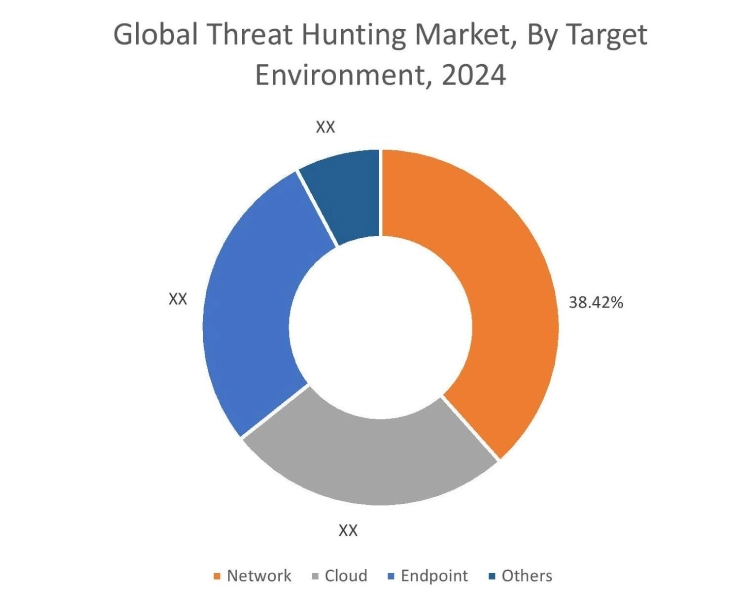
By Enterprise Type:
Based on enterprise type, the market is segmented into large enterprise and small and medium enterprise (SME).
Trends in the enterprise type:
- Increasing trend in the deployment of threat-hunting solutions in large enterprises, due to its ability to effectively detect and mitigate threats, streamline workflows, and improve overall security.
- Factors including rising investments in the development of small and medium enterprises and increasing adoption of threat-hunting services in SMEs for facilitating a cost-effective approach to identify and address threats are key trends driving the market growth.
Large enterprise segment accounted for the largest revenue in the threat hunting market share in 2024.
- Threat-hunting solutions play a vital role in large enterprises to proactively identify and neutralize advanced cyber threats that bypass standard security measures.
- These solutions leverage advanced analytics, threat intelligence, and human expertise for detecting anomalies and malicious activities within an organization's infrastructure.
- Moreover, large enterprises benefit significantly from threat-hunting solutions, due to its ability to effectively detect and mitigate threats, streamline workflows, and improve overall security.
- Additionally, large enterprises primarily use threat-hunting services as an effective approach for securing their data, applications, and network infrastructure against cyberattacks.
- Therefore, the increasing adoption of threat-hunting solutions in large enterprises is driving the threat hunting market trends.
Small and medium enterprise (SME) segment is anticipated to register the fastest CAGR during the forecast period.
- Small and medium enterprises are companies that typically maintain workforce, revenues, and assets below a certain threshold.
- Moreover, SMEs usually account for the majority of the businesses that are operating across the world.
- Additionally, threat-hunting solutions are being increasingly used in SMEs to proactively identify and mitigate cyber threats.
- These solutions involve actively searching for malicious activity that might evade automated security tools, in turn offering a crucial layer of defense against advanced cyberattacks.
- For instance, according to the U.S. Chamber of Commerce, the total number of small businesses in the United States reached 33.2 million in 2022, accounting for nearly 99.9% of total businesses in the U.S.
- Thus, the rising number of small and medium enterprises is expected to boost the adoption of advanced security solutions, in turn driving the threat hunting market size during the forecast period.
By End Use:
Based on end use, the market is segmented into BFSI, IT & telecommunication, retail & e-commerce, government & public sector, healthcare, and others.
Trends in the end use:
- There is a rising trend towards the utilization of threat-hunting solutions in the BFSI industry for advanced threat protection, improved protection of financial transactions, compliance with regulatory standards, and maintaining operational resilience.
- Increasing adoption of threat-hunting solutions in the healthcare sector for protecting sensitive patient data along with securing the growing number of connected medical devices and applications.
BFSI segment accounted for the largest revenue in the overall market in 2024.
- BFSI (banking, financial services, and insurance) firms are one of the primary targets for cyberattacks, attributed to the sensitive nature of their transactions and data.
- Moreover, the BFSI sector faces constant cyber threats, including ransomware, phishing attacks, and sophisticated malware, making threat-hunting solution essential for maintaining security and compliance.
- Moreover, the utilization of threat-hunting solutions in the BFSI sector offers several benefits such as advanced threat protection, improved protection of financial transactions, compliance with regulatory standards, and others.
- For instance, according to the Federal Reserve Board, there are approximately 2,160 large commercial banks in the United States as of March 2025.These banks have combined assets of USD 300 million or more, with numerous branches in the U.S as well as other countries.
- According to the threat hunting market analysis, the growing BFSI sector is increasing the adoption of threat-hunting solutions, in turn propelling the market.
The healthcare segment is anticipated to register a substantial CAGR during the forecast period.
- Healthcare organizations often handle vast amounts of sensitive patient data, making it a key target for cyberattacks. Moreover, the increasing utilization of IoT-connected medical devices in healthcare creates new possibilities for cyberattacks.
- Threat-hunting solution plays a crucial role in the healthcare sector for protecting sensitive patient data, ensuring compliance with regulations such as HIPAA(Health Insurance Portability and Accountability Act), and securing the growing number of connected medical devices and applications.
- It provides healthcare organizations with a more efficient and effective way to identify and address threats, in turn strengthening their overall security posture.
- Hence, the rising adoption of threat-hunting solutions in healthcare sector is projected to drive market growth during the forecast period.
Regional Analysis:
The regions covered are North America, Europe, Asia Pacific, Middle East and Africa, and Latin America.
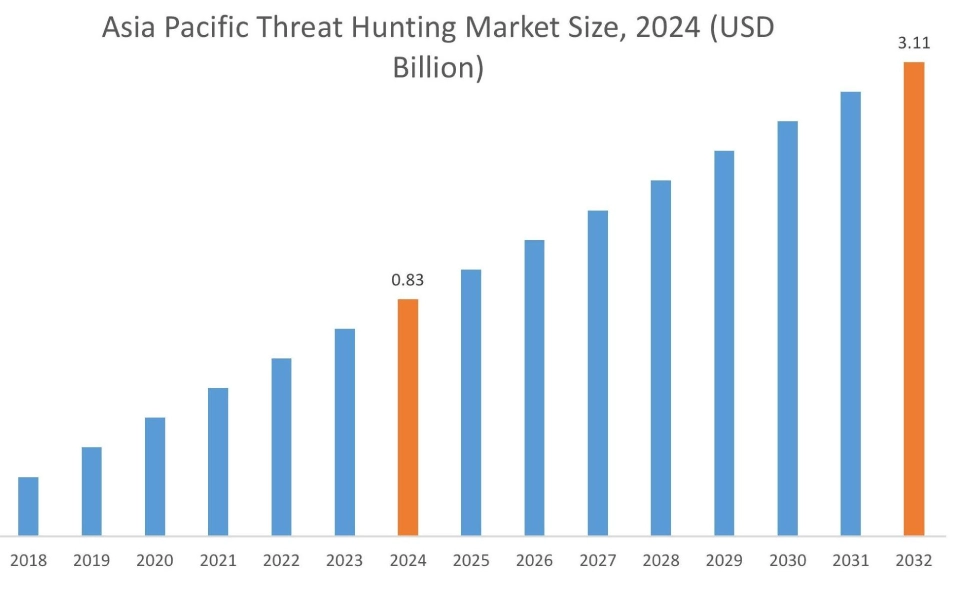
Asia Pacific region was valued at USD 0.83 Billion in 2024. Moreover, it is projected to grow by USD 0.96 Billion in 2025 and reach over USD 3.11 Billion by 2032. Out of this, China accounted for the maximum revenue share of 34.58%. As per the threat hunting market analysis, the adoption of threat-hunting solutions in the Asia-Pacific region is primarily driven by growing IT & telecom, retail & e-commerce, and government sectors, among others. Additionally, the rising number of data breaches in government organizations along with growing demand for reliable threat-hunting solutions are further accelerating the threat hunting market expansion in the region.
- For instance, in July 2022, Shanghai Municipal Police, a government organization based in China, witnessed a data breach that leaked the personal information of approximately one billion Chinese residents from the Shanghai police database stored in the cloud. The aforementioned factors are expected to drive market demand in the Asia-Pacific region during the forecast period.
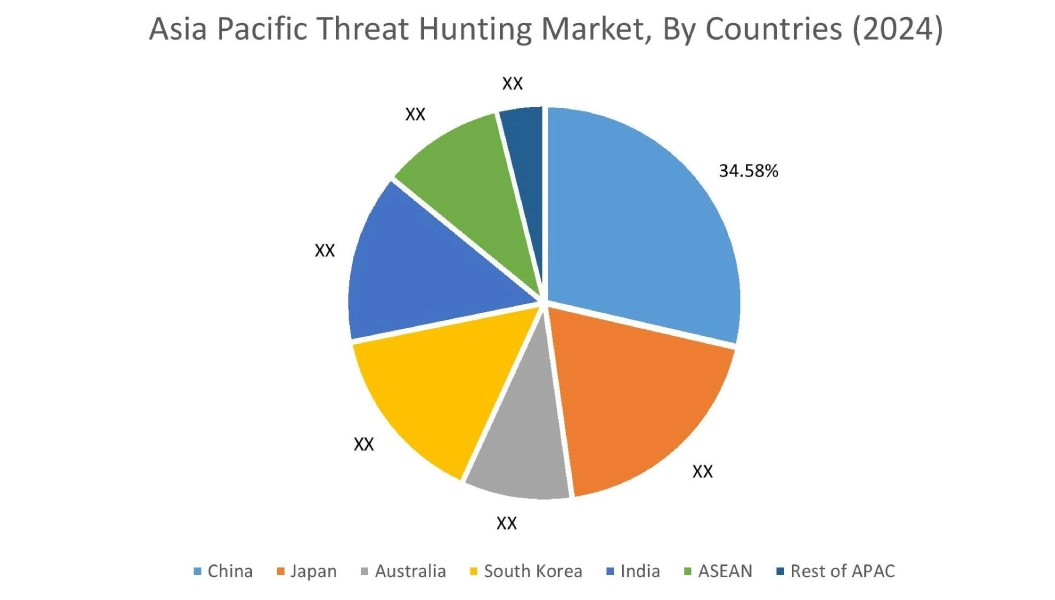
North America is estimated to reach over USD 4.95 Billion by 2032 from a value of USD 1.39 Billion in 2024 and is projected to grow by USD1.60 Billion in 2025. In North America, the growth of the threat hunting industry is driven by rising investments in BFSI, retail, healthcare, and other sectors. Moreover, the rising adoption of advanced threat-hunting solutions in BFSI sector for protecting sensitive customer data, complying with regulations, and maintaining operational resilience is contributing to the threat hunting market demand in North America.
- For instance, in July 2022, Citi Bank launched its new Citi Commercial Bank in Canada, as part of the company’s global extension plan. Citi Commercial Bank offers a broad range of institutional solutions and products to meet the evolving needs of corporates. The above factors are further propelling the market in North America.
Meanwhile, the regional analysis depicts that the growing healthcare, IT & telecom, and retail & e-commerce sectors along with increasing demand for cost-efficient threat-hunting solutions among business enterprises are driving the threat hunting market demand in Europe. In addition, according to the market analysis, the market in Latin America, Middle East, and African regions is expected to grow at a substantial rate due to several factors such as increasing investments in BFSI sector, expansion of IT firms, and rising need for robust threat-hunting solutions in government sector among others.
Top Key Players & Market Share Insights:
The global threat hunting market is highly competitive with major players providing solutions to the national and international markets. Key players are adopting several strategies in research and development (R&D), product innovation, and end-user launches to hold a strong position in the threat hunting market. Key players in the threat hunting industry include-
- CrowdStrike(USA)
- Capgemini(France)
- Rapid7 (USA)
- Sangfor Technologies (China)
- SecureWorks Inc. (USA)
- Trustwave Holdings Inc. (USA)
- IBM(USA)
- Microsoft (USA)
- Kaspersky (Russia)
- Palo Alto Networks (USA)
- Check Point Software Technologies Ltd (Israel)
Recent Industry Developments :
Launch:
- In April 2025, CrowdStrike introduced its managed threat-hunting solution Falcon Adversary OverWatch Next-Gen SIEM. This advancement aims at delivering faster detection, broader coverage, and faster speed in stopping security breaches.
Threat Hunting Market Report Insights :
| Report Attributes | Report Details |
| Study Timeline | 2019-2032 |
| Market Size in 2032 | USD 13.03 Billion |
| CAGR (2025-2032) | 15.2% |
| By Offering |
|
| By Target Environment |
|
| By Enterprise Type |
|
| By End Use |
|
| By Region |
|
| Key Players |
|
| North America | U.S. Canada Mexico |
| Europe | U.K. Germany France Spain Italy Russia Benelux Rest of Europe |
| APAC | China South Korea Japan India Australia ASEAN Rest of Asia-Pacific |
| Middle East and Africa | GCC Turkey South Africa Rest of MEA |
| LATAM | Brazil Argentina Chile Rest of LATAM |
| Report Coverage |
|
Key Questions Answered in the Report
How big is the threat hunting market? +
The threat hunting market was valued at USD 3.65 Billion in 2024 and is projected to grow to USD 13.03 Billion by 2032.
Which is the fastest-growing region in the threat hunting market? +
Asia-Pacific is the region experiencing the most rapid growth in the threat hunting market.
What specific segmentation details are covered in the threat hunting report? +
The threat hunting report includes specific segmentation details for offering, target environment, enterprise type, end use, and region.
The threat hunting report includes specific segmentation details for offering, target environment, enterprise type, end use, and region. +
The key participants in the threat hunting market are CrowdStrike (USA), Capgemini (France), IBM (USA), Microsoft (USA), Kaspersky (Russia), Palo Alto Networks (USA), Check Point Software Technologies Ltd (Israel), Rapid7 (USA), Sangfor Technologies (China), SecureWorks Inc. (USA), Trustwave Holdings Inc. (USA), and others.
